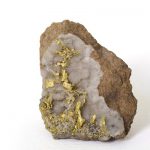 Since the success of the first coinage, our society has always had a steady demand for gold. While gold recycling satisfies a portion of this demand, the rest comes from mines around the world. However, mines are finite – so mining companies must continually search for new sources of gold. In an age with no more gold rushes or “obvious” places to look, how do miners find new sources of gold? First, it helps to understand how gold deposits form.
Since the success of the first coinage, our society has always had a steady demand for gold. While gold recycling satisfies a portion of this demand, the rest comes from mines around the world. However, mines are finite – so mining companies must continually search for new sources of gold. In an age with no more gold rushes or “obvious” places to look, how do miners find new sources of gold? First, it helps to understand how gold deposits form.
Gold deposits are formed via a very wide variety of geological processes, but they generally fall into three categories:
- Lode deposits – a lode can be a deposit of ore that fills a fissure in a rock formation, or a vein of ore embedded between layers of rock. Lodes form through a process called mineralization – when gold is dissolved in hydrothermal fluids (ultra-hot, acidic ground water) that subsequently flow into the fissures/layers of pre-existing rocks where the gold re-solidifies to form a deposit. Native gold nuggets are an example of lode deposits.
- Intrusion-related deposits – similar to lode deposits, but instead of hydrothermal fluids, magma pushes up into the cracks and fissures of rock formations, then solidifies into a mineral deposit.
- Placer deposits – are secondary deposits, meaning that they come from pre-existing lode or intrusion-related deposits. Placer deposits erode from the primary deposit, and then form via gravity separation and the alluvial process.
Miners locate new sources of gold by searching areas that have the geology to support the formation of lode, intrusion-related, or placer deposits. In addition, there are several types of geologic indicators that miners use as clues to tighten exploration efforts. We’ll cover these in an upcoming blog post.











